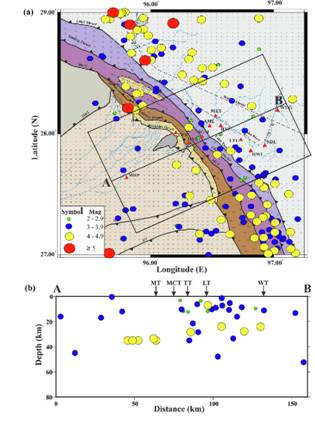Ministry of Science & Technology
Seismicity study of Arunachal Himalaya reveals low to moderate earthquakes at 2 crustal depths
प्रविष्टि तिथि:
25 JUL 2020 4:04PM by PIB Delhi
The exhumation and growth of the Himalaya is a continuous process that results predominantly from reverse faults in which the rocks on the lower surface of a fault plane move under relatively static rocks on the upper surface, a process called underthrusting of the Indian plate beneath its Eurasian counterpart. This process keeps modifying the drainage patterns and landforms and is the pivotal reason for causing an immense seismic hazard in the Himalayan mountain belt and adjoining regions, necessitating assessment and characterization of earthquakes in terms of cause, depth and intensity before construction activities are initiated.
The Tuting-Tidding Suture Zone (TTSZ) is a major part of the Eastern Himalaya, where the Himalaya takes a sharp southward bend and connects with the Indo-Burma Range. This part of the Arunachal Himalaya has gained significant importance in recent times due to the growing need of constructing roads and hydropower projects, making the need for understanding the pattern of seismicity in this region critical.
A study by the Wadia Institute of Himalayan Geology (WIHG) an autonomous institute of the Department of Science & Technology (DST), Government of India, exploring the elastic properties of rocks and seismicity in this easternmost part of India revealed that the area is generating moderate earthquakes at two different depths. Low magnitude earthquakes are concentrated at 1-15 km depth, and slightly higher greater than 4.0 magnitude earthquakes are mostly generated from 25-35 km depth. The intermediate-depth is devoid of seismicity and coincides with the zone of fluid/partial melts.
The crustal thickness in this area varies from 46.7 km beneath the Brahmaputra Valley to about 55 km in the higher elevations of Arunachal, with a marginal uplift of the contact that defines the boundary between crust and the mantle technically called the Moho discontinuity.
This, in turn, reveals the underthrusting mechanism of Indian plate in the Tuting-Tidding Suture Zone. Extremely high Poisson’s ratio was also obtained in the higher parts of the Lohit Valley, indicating the presence of fluid or partial melt at crustal depths. This detailed assessment of seismicity in this region will be helpful for planning any largescale construction in this region in the future.
The team of scientists led by Dr. Devajit Hazarika installed 11 broadband seismic stations along the Lohit River Valley of Arunachal Himalaya to understand the elastic properties of rocks and seismicity in this easternmost part of India, a study that has been published in the ‘Journal of Asian Earth Sciences’.
In the present study, the WIHG team used both teleseismic (earthquakes that occur more than 1000 km from the measurement site)and local earthquake data with the help of seismometers having a flat velocity response for the frequency range of 0.004-35 Hz. Data were continuously recorded at 20 samples per second, and the Global Positioning System (GPS) receivers were used for time synchronization. The study which used teleseismic and local earthquake data procured during January 2007-June 2008 has helped map underthrusting in this easternmost part of the country and can not only help plan construction but also improve earthquake preparedness in the area.
(Publication link:
https://doi.org/10.1016/j.jseaes.2019.104099 )

Fig. Spatial distribution of seismicity in and around the Tidding Suture Zone based on the earthquakes recorded by 11 broadband seismological stations (red triangles) during 2007–2008 and data obtained from the reviewed catalogue of the International Seismological Centre (ISC) for the period 1950–2016 (http://www.isc.ac.uk). Depth distribution of the earthquakes near the study profile marked by rectangular areas on either side of the AB profile is shown in (b). The main tectonic features marked on the profile are Mishmi Thrust (MT), Main Central Thrust (MCT), Tidding Thrust (TT), Lohit Thrust (LT), and Walong Thrust (WT).
*****
NB/KGS/(DST Media Cell)
(रिलीज़ आईडी: 1641185)
आगंतुक पटल : 2814